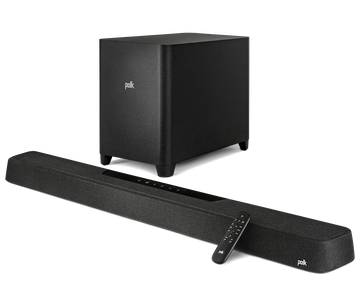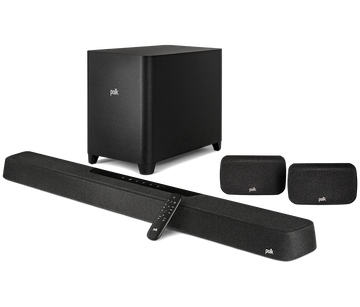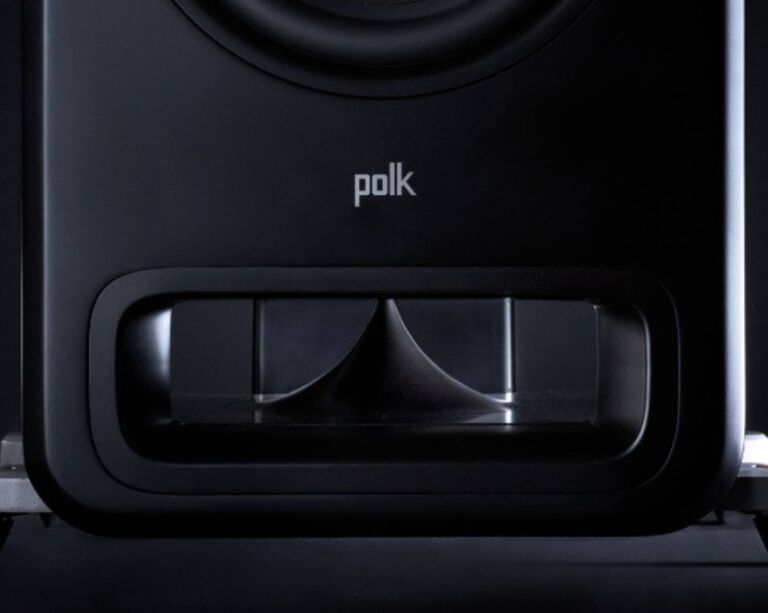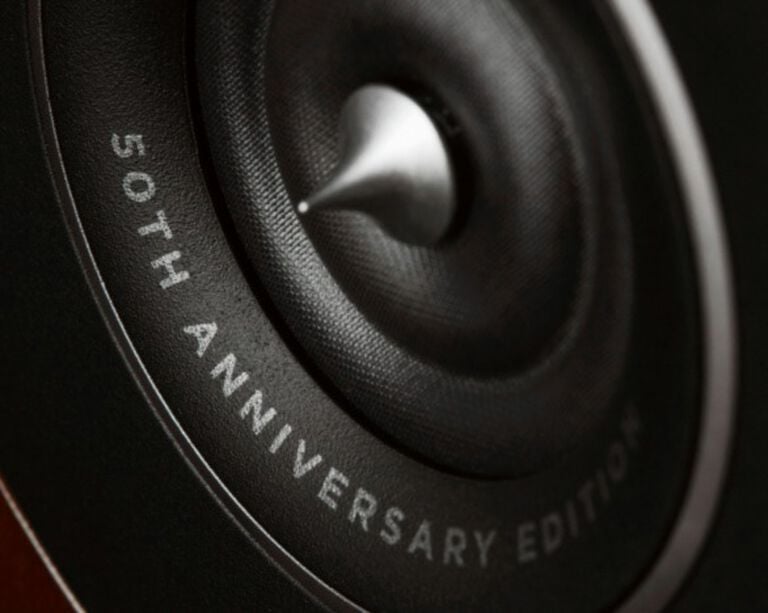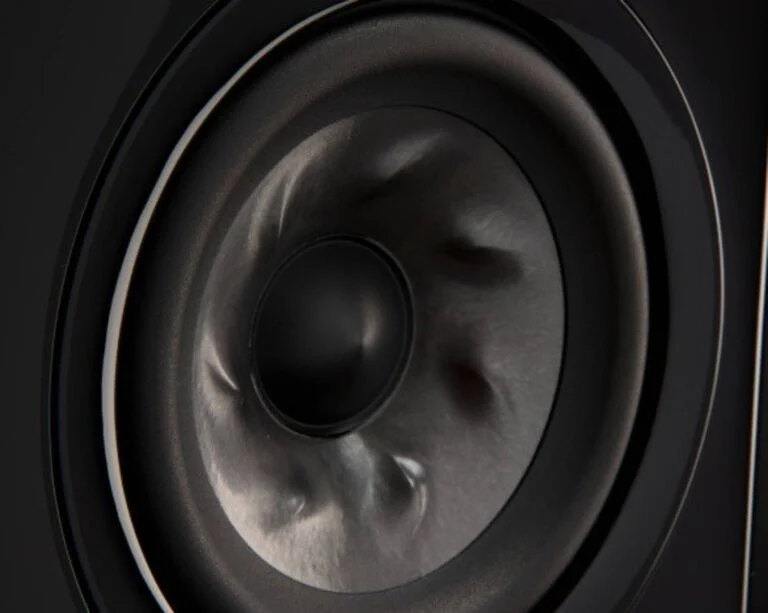The Ultimate Guide to Dolby Atmos, Part 2: What Kind of System is Right for Me?
Article written by SARAH JONES

Thinking of upgrading to Dolby Atmos but don’t know where to start? You’ve come to the right place. In this second installment of our four-part series exploring this groundbreaking immersive sound format, we’ll help you figure out which type of system is best for you.
(New to the series? Start with our first installment, where we explain the difference between Dolby Atmos and traditional surround sound, and outline everything you need to enjoy immersive Atmos sound at home.)
Choosing the Right Dolby Atmos System
Dolby Atmos content is speaker agnostic and is fully playback-compatible with most home theater systems. With support for as many as 34 discrete speakers, Atmos’ scalability allows for a huge range of playback and speaker configurations.
The height dimension is key to the Atmos experience, but reproducing overhead sounds means thinking about your home theater or music-listening space in a new way.
Practicalities of Recreating the Cinema Experience at Home
When you’re at the movie theater, you’re completely immersed in sound because speakers are everywhere: in front of you, behind the screen; along all of the walls; and in the ceiling. Recreating this setup at home is the best way to experience true Atmos surround, but isn’t always practical or appropriate for your space. The beauty of Atmos is that you can experience immersive sound—with that critical height element—on a whole range of systems, from component systems with upfiring speakers to sound bars. It’s all about making the right choices for your space, your budget, and your preferences.
True Vs. Virtualized Atmos
In real life, we hear sounds coming from all around us, including over our heads. The ability to re-create that enveloping environment—360 degrees around you and overhead—is what makes Dolby Atmos sound so realistic. For this reason, the more discrete speakers in your system, the more realistic and immersive things sound.
Atmos virtualization processing uses sound physics and psychoacoustics to digitally simulate an immersive audio experience with as few as two speakers (or a pair of headphones). So if installing a dozen or more speakers in your room is a deal breaker, you’ll be relieved to know that you can experience convincing, immersive Atmos sound from even the most compact sound bar. The virtual Atmos effect, which provides the sensation of overhead sounds from listener-height speakers, is natural and convincing. And for many people, the simplicity of a small, all-in-one sound bar is worth it.
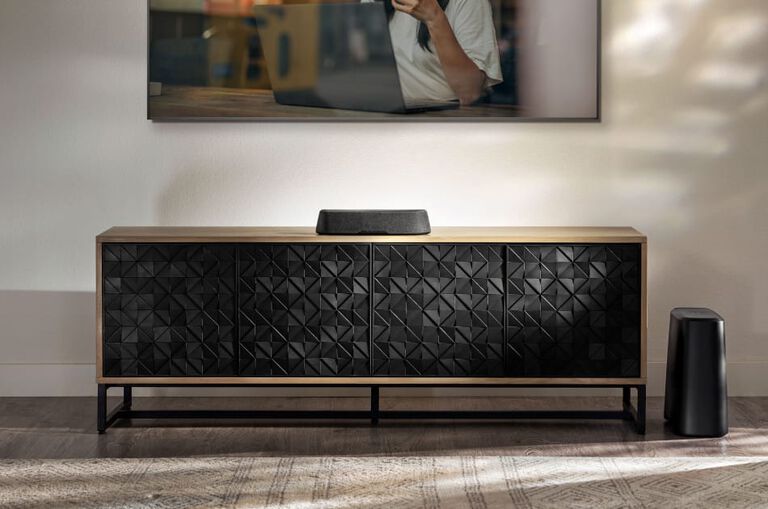
The Polk MagniFi Mini AX Dolby Atmos sound bar is just 13 inches wide
Sound Bars
As flat-screen, high-def TVs have gotten slimmer, their built-in speakers have gotten smaller. As a result, these tiny drivers have been downsized to the point where the only way to experience sound quality on par with the dazzling visuals onscreen is to add external full-range speakers.
For gear minimalists, a sound bar is a discreet and unobtrusive way to experience Dolby Atmos sound without cramming a small space with speakers and components or wiring (or re-wiring) an entire room. Some sound bars include a wireless subwoofer and surrounds, offering the truer surround experience of a component system in a compact, convenient package.
Adding Height With Up-Firing Drivers
Though each manufacturer takes a different approach to reproducing Atmos sound, Atmos-enabled sound bars include both front-firing drivers and upward-firing drivers that point sound at the ceiling, where it reflects back to the listener, producing the same height sounds that would be produced by Atmos ceiling speakers.
Advanced sound bars such as the Polk Signa S4 and MagniFi Max AX include up-firing drivers; others incorporate sophisticated 3D virtualization processing that provides a wider sound and a greater sense of immersion than you’d experience in traditional sound bars.
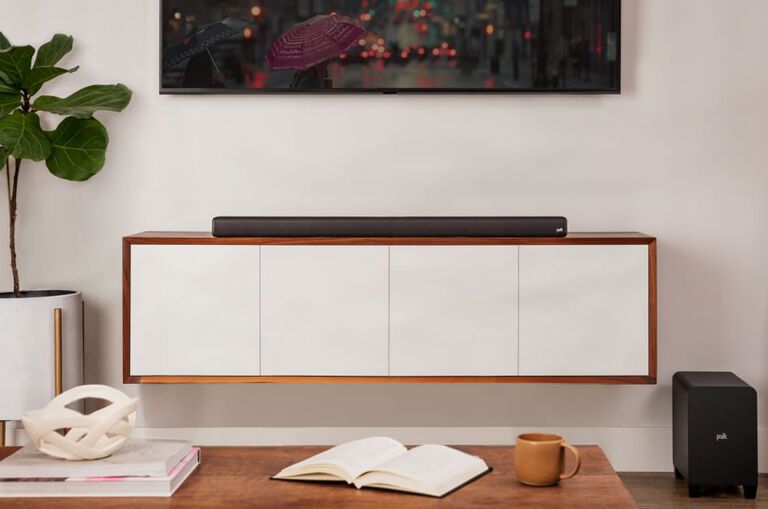
Polk Signa S4
Component Systems
If you have the space and the inclination to tackle a bit of installation and wiring, a system of discrete speakers and subwoofer paired with an Atmos-enabled A/V receiver provides the best Atmos sound. It’s the closest approximation to cinema sound, bringing you right into the middle of the action with fully immersive sound with big dynamics, crystal-clear speech, and couch-shaking bass.
Component systems are more costly and complex than sound bars, but for those seeking the ultimate Atmos experience at home, they’re worth the money and effort. Luckily, most Atmos-capable receivers make things easier by automating speaker setup, configuring for your speaker array, and balancing speaker volume levels.
To experience the most authentic Atmos sound, you’ll need a minimum 5.1.2 speaker setup. (Dolby recommends four height speakers for the best results.) That’s five front-firing speakers (left, center, right, and surrounds), a subwoofer, and two height speakers, which can be upfiring or mounted on (or in) the ceiling to direct sound downward.
For main left/center/right speakers, surrounds, and rear speakers, you can use floor-standing speakers, bookshelf speakers, on-wall speakers, or in-wall speakers. You can use any subwoofer that blends with your speaker system; Polk systems are timbre-matched for seamless sound. Multiple subs are encouraged for consistent bass response throughout the room and maximum sonic impact.
In-Ceiling Height Speakers
Height sound is a defining element of Dolby Atmos. In-ceiling speakers sometimes provide the best Atmos height experience, but they can be impractical, requiring professional installation or advanced home-improvement skills. And at ceiling heights below ten feet, Atmos sound can feel unnaturally close.
But in the right spaces with ideal dimensions, ceiling speakers deliver multidimensional sound that offers the same type of sonic immersion you’d experience in a movie theater. Many overhead speakers with wide dispersion patterns are suitable for Atmos; ideally, choose speakers that are timbre-matched to the rest of your system. (Technically, you can even mount bookshelves on your ceiling, but they’re not acoustically optimized for this application, and they don’t exactly disappear into your décor.)
On-Speaker Height Modules
For a practical alternative to installing ceiling speakers, most people opt for Dolby Atmos-enabled height speakers, which provide the critical height element by firing sound upward toward the ceiling, where it reflects back down to the listing position. If appropriately placed and used with a low, level ceiling, height speakers offer sound that’s comparable to ceiling-mounted speakers. These speakers are most effective with ceiling heights of eight to nine feet, without slopes or angles. Recessed lighting, chandeliers, crown molding, and ceiling vents do not noticeably impact the Atmos sound.
Atmos-enabled height speakers are available as integrated speakers, which combine traditional front-firing drivers and an upward-firing Atmos driver in the same cabinet, or as add-on height modules, which are housed in their own cabinets and sit on top of primary speakers to provide multidimensional sound. Add-on modules are ideal if you want an Atmos experience using your existing sound system; look for speakers that closely match the timbre of listener-level speakers.
As tempting as it is to repurpose those old bookshelf speakers, you shouldn’t use just any speaker for upfiring Atmos sound. Atmos upfiring height speakers work by projecting highly directional sound, and become Dolby-licensed by meeting certain acoustic specifications.
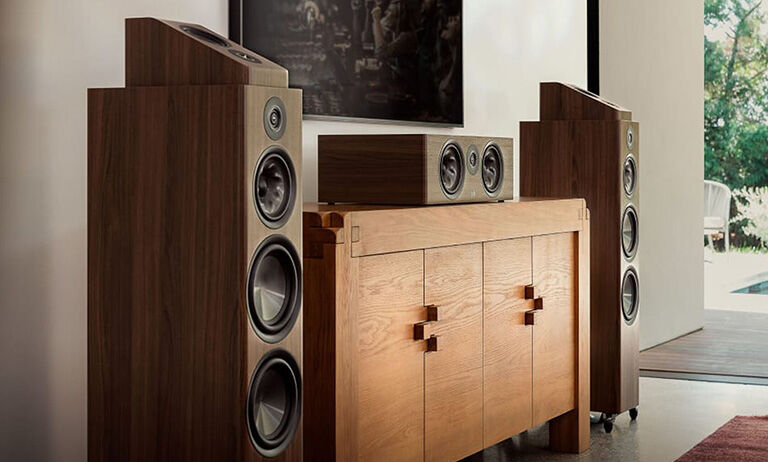
Reserve towers with R900 height modules installed
Dolby Atmos-Ready Receiver
For home theater, you’ll need an AV receiver or processor that can decode Dolby Atmos. It’ll power your speakers and receive and process incoming audio signal before sending it to your system. Most receivers produced since 2018 offer Atmos support.
Atmos-enabled receivers can process Atmos-encoded content, and usually also support other immersive formats including DTS:X and Auro 3D. If your AV receiver supports Atmos decoding, it will also have enough output channels to install at least two overhead speakers, which is the minimum requirement. Typically, Atmos-enabled receivers support up to 11 channels, which allows a 7.1.4 speaker configuration. Top-of-the-line models can support up to 11.1.6 systems.
Make the Right Connections: Hdmi Arc VS. Hdmi Earc
Whether your Atmos content comes from a Blu-ray disc, a streaming box, game console, or app on your TV, you need an HDMI ARC connection to transmit the data-dense signal into your AV receiver or sound bar. If you’re using an optical cable to connect your TV to your receiver or sound bar, information will be converted to a simpler surround format, such as Dolby Digital 5.1, before it’s transmitted. The sound you hear might be great, but it won’t be Atmos.
HDMI ARC (for Audio Return Channel) allows two-way digital communication between devices, which means fewer expensive cables and installation headaches. And HDMI ARC supports the Dolby Digital Plus codec, which is the lossy compression scheme used to transmit Atmos through streaming devices.
If you play lossless, high-bandwidth Atmos content on Blu-ray, you’ll need equipment that supports the newer HDMI standard, HDMI eARC (for enhanced Audio Return Channel), which supports Dolby TrueHD.
With so many choices, your options may seem overwhelming. We’ll cut through the clutter in part three of our series, when we’ll break down our favorite Atmos systems in every size and price category.
